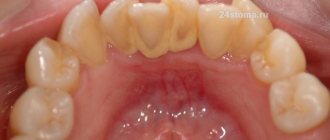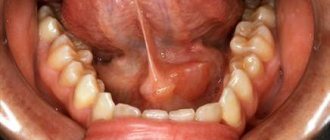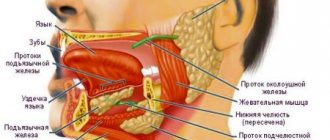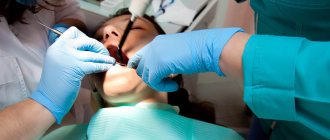Causes
The cyst appears as a tumor under the cheekbone, protruding from the outside. If left untreated, inflammatory processes appear, which can lead to the formation of an abscess or phlegmon. The pathology is a rare formation, usually diagnosed before the age of thirty. Place of development - on the lips, cheeks, palate, less often - in the sublingual ducts. Very rare is the pathology of the glands that develops in the parotid and mandibular areas.
The causes of this pathology are:
- injuries, wounds of the mucous membrane;
- mucus plugs that appear in the ducts;
- stomatitis and other inflammatory processes leading to obstruction;
- formation of salivary stones;
- pressure on the ducts;
- scar type narrowing.
Causes also include developmental defects, genetic predisposition, and damage to certain tissue areas. But more often the problem develops against the background of tissue injury and inflammatory processes. Wounds are formed by frequent biting of the cheek or tongue, due to the abuse of rough, spicy food, and hot dishes. In addition, such injuries can cause gland atrophy, so they cannot be ignored.
Retention cyst on the lip: treatment
A lump on the inside of the lip is treated in the same way as a lump under the tongue.
There is only one treatment option - surgery, which involves removing the entire cyst (there are no other treatment options). The surgery is very simple and usually does not take more than 15 minutes of the dental surgeon's time. It is performed under local anesthesia with lidocaine solution, and you will not feel any pain at all. It looks like this: a small incision is made on the surface of the mucous membrane next to the cyst, through which the entire cyst is removed, along with its contents. After this, 2-4 sutures are placed on the edges of the mucous membrane, which will need to be removed after about 7 days.
Removal of a retention cyst: video of the operation
During the operation, it is very important not to damage the cyst membrane, because if the walls of the cyst collapse, it is immediately lost in the tissues, and it is almost impossible to remove it entirely after this. If you leave a small fragment of the cyst shell in the tissues, the retention cyst on the lip will appear again.
Signs, diagnosis and treatment
Manifestations of the disease depend on the location of the cyst. Most often, these are rounded formations that slowly increase in size, elastic and soft to the touch. They do not cause pain at first, rarely exceeding 1 cm in diameter. But in the absence of treatment, cysts begin to seriously interfere not only with eating, but also during conversation. The formation may disappear if, due to an accidental breakthrough, the contents come out. However, over time, the cyst forms again; if its size becomes very large, it acquires a characteristic bluish tint.
For diagnosis, methods such as visual inspection, palpation, and a number of hardware studies are used. Ultrasound, sialography to determine the problem with contrast, MRI and CT are more often performed. Additional examination methods may also be prescribed, for example, cystography of the bladder, probing of the salivary ducts, histology. If the diagnosis is questionable, a biopsy and puncture of samples are performed.
Conservative therapy does not bring any effect; when diagnosing a cyst of this type, surgical intervention is recommended. For this, local anesthesia is used, after which the formation is removed along with the affected gland and membrane to prevent relapses. If surgical intervention is refused, the formation often develops into phlegmon, and a tissue abscess develops.
The conservative method provides only temporary results. To do this, the membrane is punctured and the contents of the cyst are sucked out. But in all cases, the formation appears again, that is, this method of therapy is not recommended, as it is ineffective.
Surgery includes the following steps:
- inspection and surface preparation are carried out;
- local anesthesia methods are used for pain relief;
- the area with the cyst shrinks, which reduces blood flow and ensures stability of the tissue position;
- two oval-shaped incisions are made near the formation, after which the contents are husked;
- the affected lobes of the gland are removed, which helps to avoid complications or relapses in the future;
- the wound is sutured, thin sutures are applied, and self-absorbing sutures are often used.
The contents of the capsule are sent for additional research. This helps to eliminate serious risks, especially if the development of malignant processes is suspected. In case of serious intervention, plastic cystotomy is recommended. Typically, this situation occurs when removing a maxillary-hyoid formation.
Cyst removal
Sometimes, especially if the drained cyst recurs, surgical removal of the mucocele may be required. Complications from such interventions are extremely rare and include risks standard for surgical operations, such as infection and adverse reactions to local anesthesia. Be sure to consult with your dentist and surgeon to make sure you understand the risks.
If the cyst does not burst on its own, then if left untreated, a permanent lump may form in its place. Such bumps are harmless, but in general, if any tumors appear in the oral cavity, you should consult a dentist. It is important that he carefully examine the suspicious area of the oral cavity and, if necessary, conduct the necessary research, because your dental health is an integral part of the health of the whole body.
Rehabilitation, expected results
After surgery, there is slight swelling and pain at the operation site for two to three days. The doctor may prescribe medications to eliminate such unpleasant symptoms, for example, analgesics, antibiotics to avoid complications. Oral rinses using special antiseptic solutions are also prescribed.
If the healing process is normal, the sutures are removed after a week, after which a pressure bandage is applied. During recovery, it is recommended to avoid solid, spicy foods, too cold and hot dishes. Oral care also requires care to avoid damaging the operated area.
The prognosis for treatment is favorable; if therapy is carried out correctly and the patient follows all recommendations, there are no problems. But in some cases there are risks of complications. These include relapses, damage to the facial nerve or facial muscles when removing a cyst in the ear area. To reduce risks after completion of the recovery period, it is recommended to correct the shape of the tooth and install new orthodontic structures or dentures. In addition, prevention is needed, protection from injuries to the mucous membrane, and compliance with the rules of oral care.
Salivary gland cysts
Symptoms of a salivary gland cyst
Depending on which gland it forms in, the symptoms of a salivary gland cyst can be distinguishable.
Small gland cyst
If a small gland has undergone a neoplasm, then the cyst is noticeable on the surface of the mucosa from the lower lip, and less often - on the mucosa of other parts. The small gland cyst does not exceed 1 cm in diameter and grows slowly. In appearance, it is a round elastic movable sphere protruding above the mucous membrane. It is practically imperceptible to the patient. If accidentally bitten or damaged by hard food, the cyst opens and secretes a viscous fluid, after which it closes again and mucus accumulates inside it again.
Sublingual gland cyst
Its location is under the base of the tongue. Such a cyst has a spherical or oval shape and a bluish light tint. When the cyst is located near the mylohyoid muscle, it takes on an hourglass shape.
A cyst of the sublingual gland can cause inconvenience because, as it increases in size, it provokes displacement of the frenulum of the tongue. Its incorrect position causes difficulties while eating and talking. Periodically, the cyst may spontaneously empty and be filled again with transparent or translucent secretion due to the fact that the gland continues its work.
Submandibular gland cyst
This cyst manifests itself as a fluctuating, round-shaped formation with a soft, smooth surface, located in the lower jaw, closer to the jaw joint. It can also spread to the sublingual area of the oral cavity and manifest itself as swelling of its bottom. In advanced cases, a submandibular gland cyst causes facial deformation. Like other types of similar neoplasms, this cyst can empty and fill again with liquid contents.
Parotid cyst
The parotid type of cyst, like others, has the shape of a ball with an elastic structure. A cyst forms on the mucous membrane inside the mouth near the auricle. Typically, a parotid cyst affects only one side of the mouth, which can cause facial deformity due to swelling of one cheek. The skin over the site of the cyst does not change color or structure. On palpation, the gland affected by the cyst does not show signs of fluctuation and does not cause pain.
In the absence of treatment and subsequent infection, the cyst can be complicated by abscess processes, accompanied by hyperemia of the skin and pain in the ear area. In this case, opening the mouth becomes very difficult, fluctuation and a slight increase in temperature in the tissues of the cheek are observed.
Types of benign tumors of the tongue
Papilloma
Focal skin growth caused by activation of the human papillomavirus in the body. The virus is transmitted when the tongue comes into contact with the mucous membrane or skin of an infected person. In the rarest cases, transmission of the virus occurs through household contact. The virus can remain dormant for a long time and appear when the immune system is weakened.
Externally, papillomas look like small pink, flesh-colored or white papillae of various shapes. Their size usually does not exceed two centimeters. You can detect these tumors yourself. They are usually localized on the back, surface and tip of the tongue. These small tumors pose a serious threat to human health because they are very often damaged and susceptible to malignancy.
Adenoma
The occurrence of this tumor is caused by the proliferation of glandular epithelium. As a rule, neoplasms are single. The following types of tongue adenoma are distinguished:
- polymorphic;
- basal cell;
- canalicular;
- sebaceous;
- adenolymphomas;
- monoform.
The pathology is usually accompanied by the formation of polyps on the tip of the tongue.
Botriomyxoma
A benign tumor of the tongue, the occurrence of which is caused by traumatic injuries - burns, cuts, injections. A couple of months after the injury, a red tumor-like formation with a lobulated or smooth surface may appear in its place. Botriomyxoma has a dense elastic consistency, sits on a stalk, and with minor damage begins to bleed.
Fibroma
A neoplasm that is formed from connective tissues covered with mucous membrane. Usually appears as small nodules, but can also look like branched polyps. The main causes of the disease are traumatic and inflammatory processes in the oral cavity. Most often, a tumor forms against the background of advanced inflammatory dental diseases - stomatitis, glossitis, periodontitis, gingivitis.
Retention cyst
The tumor occurs due to problems with the outflow of secretion from the gland, which causes blockage of the duct. Because of this, the secretion gradually accumulates in the gland, stretches it and fills it with new contents. This type of tumor is removed surgically.
Lipoma
A tumor that is predominantly localized in the back of the tongue. A lipoma forms in the submucosal layer of the tongue and has a soft and elastic consistency. Often the process of lipoma formation occurs without symptoms, so diagnosing it at an early stage is extremely difficult.
Myoma
A tumor in the tongue that occurs due to the growth of muscle tissue. Myoma has a fairly dense consistency, is covered with a mucous membrane, and small papillary outgrowths can form on it. This tumor usually reaches a centimeter in size.
Neurofibroma
A tumor develops from the sheaths of peripheral nerves. Doctors associate its formation with a defect of the facial or trigeminal nerve. This tumor is extremely rare.
Hemangioma
This is a vascular neoplasm that occurs in the tissues of blood vessels. The tumor is benign - it grows quite slowly and does not penetrate other organs. However, hemangioma is completely unpredictable, as it can suddenly increase in size and begin to interfere with the functioning of the tongue. Depending on the structure of the tumor, it can be of two types: simple (looks like a tangle of capillaries located on the mucous membrane of the tongue) and cavernous (a tangle of large vessels under the mucous membrane of the tongue).
Lymphangioma
The tumor usually grows in the walls of the lymphatic vessels, which then leads to a significant increase in the size of the tongue. Tumors often form on the tip of the tongue and its surface.
Struma of the tongue
A congenital pathology that occurs due to a violation of the location of fragments of the thyroid gland. It looks like a small organic node. After surgical removal of the tumor, the prognosis for the patient is favorable.
Causes of pain under the tongue
- Allergic reactions cause tissue swelling and pain.
- Harmful microorganisms that appear in the mouth during a sore throat cause acute inflammation. Often, it affects the floor of the mouth.
- Mechanical injuries from a bruise or a fall damage blood vessels, nerves, and soft tissues. Vessels may rupture, which will lead to the accumulation of blood between the muscle fibers.
- Some untreated diseases lead to phlegmon, inflammation with pus inside. In most cases, phlegmon appears under the tongue.
- Ordinary caries, if left untreated, causes inflammation that reaches the sublingual area.
- There are many ducts in the salivary gland, and if an infection gets into it, then through these ducts it can easily enter the gland tissue.
- Injury to the frenulum of the tongue. In people with a congenital short frenulum, injuries occur more often. Even a normal conversation can cause a breakup. However, people with a normal frenulum size also suffer. Inflammatory diseases and allergic reactions often lead to injury, leading to swelling of the tongue and the appearance of ulcers. But also improper oral hygiene leads to damage to the frenulum - the so-called dangerous brushing.
Some people have asymmetry of the hyoid bone from birth, and sometimes this anomaly is formed due to injury. Asymmetry prevents the organs of the floor of the mouth from functioning properly.










